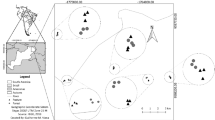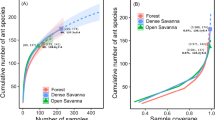Abstract
Ants are being widely studied in different Brazilian biomes due to their sensitivity to environmental changes. Therefore, in order to evaluate the effect of climatic variables on species richness, as well as the impact caused by vineyards on the epigeic ant fauna in the region of the Pampa biome, more specifically in the physiographic region of Campanha, in the state of Rio Grande do Sul, a survey was performed on three farms, for a period of 2 years. On each farm, samples were obtained within the vineyards and in the surrounding grassland vegetation, which is similar to that which preceded the cultivation of vines. Twenty pitfall traps were installed in each environment. A total of 70 species belonging to 24 genera and seven subfamilies were collected. The analysis confirmed that the species richness was influenced by temperature and rainfall, and that the vineyards behave like other agricultural systems, causing a significant change in the structure of the ant assemblage when compared to grassland areas.





Similar content being viewed by others
References
Agosti D, Alonso LE (2000) The all protocol: a standard protocol for the collection of ground-dwelling ants. In: Agosti D, Majer JD, Alonso LE, Schultz TR (eds) Ants-Standard methods for measuring and monitoring biodiversity. Smithsonian Institution Press, Washington, p 204–206
Andrade T, Marques GDV, Del-Claro K (2007) Diversity of ground dwelling ants in Cerrado: an analysis of temporal variations and distinctive physiognomies of vegetation (Hymenoptera: Formicidae). Sociobiology 50:1–14
Bilenca D, Miñarro F (2004) Identificación de áreas valiosas de pastizal en las pampas y campos de Argentina, Uruguay y Sur de Brasil (AVPs). Fundación Vida Silvestre Argentina, Buenos Aires, p 323
Bolton B, Alpert G, Ward PS, Naskrecki P (2006) Bolton′s Catalogue of ants of the world. Harvard University Press, Cambridge
Borcard D, Gillet F, Legendre P (2011) Numerical ecology with R. Springer, New York
Braga DL, Louzada R, Zanetti R, Delabie JHC (2010) Avaliação rápida da diversidade de formigas em sistemas de uso do solo no Sul da Bahia. Neotrop Entomol 39:464–469
Castilho GA, Noll FB, Silva ER, Santos EF (2011) Diversidade de Formicidae (Hymenoptera) em um fragmento de floresta Estacional Semidecídua no Noroeste do estado de São Paulo, Brasil. R Bras Bioci 9:224–230
Chagas ACS, Vasconcelos VO (2002) Comparação da frequência da atividade forrageira da formiga Pachycondyla obscuricornis (Emery, 1890) (Hymenoptera, Formicidae) no verão e no inverno, em condições de campo. Rev Bras de Zooci 4:97–109
Chao A (1987) Estimating the population size capture-recapture data with unequal catchability. Biometrics 43:783–791
Coelho IR, Ribeiro SP (2006) Environment heterogeneity and seasonal effects in ground-dwelling ant (Hymenoptera: Formicidae) assemblages in the Parque Estadual do Rio Doce, MG, Brazil. Neotrop Entomol 35:19–29
Colwell RK, Coddington JA (1994) Estimating terrestrial biodiversity through extrapolation. Phil Trans Roy Soc 345:101–118
Colwell RK, Mao CX, Chang J (2004) Interpolating, extrapolating and comparing incidence-based species accumulation curves. Ecol 85:2717–2727
Corrêa MM, Fernandes WD, Leal IR (2006) Diversidade de formigas epigéicas (Hymenoptera: Formicidae) em capões do Pantanal Sul Matogrossense: Relações entre riqueza de espécies e complexidade estrutural da área. Neotrop Entomol 35:724–730
Crawley MJ (2007) The R book. Chichester, UK
Delabie JHC, Agosti D, Nascimento ICD (2000) Litter ant communities of the Brazilian Atlantic rain forest region. In: Majer JD, Agosti D, Alonso L, Schultz T (eds) Sampling ground-dwelling ants: case studies from the worlds’ rain forests. Sch of Environ Biol, Perth, Western Australia, pp 1–17
Dias NS, Zanetti R, Santos MS, Louzada J, Delabie JHC (2008) Interação de fragmentos florestais com agroecossistemas adjacentes de café e pastagem: respostas das comunidades de formigas (Hymenoptera, Formicidae). Iheringia Zool 98:136–142
Fonseca RC, Diehl E (2004) Riqueza de formigas (Hymenoptera, Formicidae) epigéicas em povoamentos de Eucalyptus spp. (Myrtaceae) de diferentes idades no Rio Grande do Sul, Brasil. Rev Bras Entomol 48:95–100
Fortes AB (1959) Geografia física do Rio Grande do Sul. Globo, Porto Alegre
Gonçalves C (1961) O Gênero Acromyrmex no Brasil. Stud Entomol 4:113–180
Gotelli NJ, Colwell RK (2001) Quantifying biodiversity: procedures and pitfalls in the measurement and comparison of species richness. Ecol Lett 4:379–391
Hölldobler B, Wilson EO (1990) The Ants. Harvard University Press, Cambridge, vol 248, pp 897–898
IBGE—Instituto Brasileiro de Geografia e Estatítisca (2004) Mapa de biomas do Brasil. http://www.ibge.gov.br/home/presidencia/noticias/noticia_visualiza.php?id_noticia=169. Accessed 23 April 2012
Ilha C, Lutinski JÁ, Pereira DVM, Garcia FRM (2009) Riqueza de formigas (Hymenoptera: Formicidae) da Bacia da Sanga Caramuru, município de Chapecó-SC. Biotemas 22:95–105
INMET—Instituto Nacional de Meteorologia. http://www.inmet.gov.br/html/observacoes.php?lnk=Autom%E1ticas. Accessed 20 May 2012
Kaspari M (2003) Introducción a la ecología de las hormigas. In: Fernández F (ed) Introducción a las Hormigas de la región Neotropica. Instituto de Investigación de Recursos Biológicos Alexander Von Humboldt, Bogotá, Colombia, pp 97–112
Kaspari M, Weiser MD (2000) Ant activity along moisture gradients in a Neotropical forest. Biotrop 32:703–711
Kempf WW (1965) A revision of the neotropical fungus-growing ants of the Genus Cyphomyrmex Mayr—part II: group of rimosus (Spinola) (Hym. Formicidae). Stud Entomol 8:163–200
Kindt R, Vandamme P, Simons AJ (2006) Patterns of species richness at varying scales in western Kenya: planning for agroecosystems diversification. Biodiv Conserv 15:1253–1270
Köppen W (1936) Das geographisca system der klimate. In: Köppen W, Geiger G (eds) Handbuch der Klimatologie. Gebrüder, Borntraeger, Berlin pp 1–44
Lapolla J, Brady S, Shattuck S (2010) Phylogeny and taxonomy of the Prenolepis genus-group of ants (Hymenoptera: Formicidae). J Entomol Ser B 35:118–131
Legendre P, Legendre L (2012) Numerical ecology. Elsevier, Amsterdam, p 1006
Lobry de Bruyn LAL (1999) Ants as bioindicators of soil function in rural environments. Agric Environ 74:425–441
Longino JT, Fernández F (2007) Taxonomic review of the genus Wasmannia. In: Snelling RR, Fisher BL, Ward PS (eds) Advances in ant systematics (Hymenoptera: Formicidae): homage to E. O. Wilson—50 years of contributions. Memoirs of the American Entomological Institute, Gainesville, Florida, pp 271–289
Lopes DT, Lopes J, Nascimento ICD, Delabie JHC (2010) Diversidade de formigas epigéicas (Hymenoptera, Formicidae) em três ambientes no Parque Estadual Mata dos Godoy, Londrina, Paraná. Iheringia Zool 100:84–90
Lutinski JA, Garcia FRM (2005) Análise faunística de Formicidae (Hymenoptera: Apocrita) em ecossistema degradado no município de Chapecó, Santa Catarina. Biotemas 18:73–86
Majer JD (1983) Ants: bio-indicators of minesite rehabilitation, land-use, and land conservation. Environ Manag 7:375–383
Marchiori JNC (2004) Fitogeografia do Rio Grande do Sul: campos sulinos. Porto Alegre, Ed EST, p 110
Marinho CGS, Zanetti R, Delabie JHC, Schlindwein MN, Ramos LS (2002) Diversidade de formigas (Hymenoptera: Formicidae) da serapilheira em eucaliptais (Myrtaceae) e área de cerrado de Minas Gerais. Neotrop Entomol 31:187–195
Martins L, Almeida FS, Mayhé-Nunes AJ, Vargas AB (2011) Efeito da complexidade estrutural do ambiente sobre as comunidades de formigas (Hymenoptera: Formicidae) no município de Resende, RJ, Brasil. Rev Bras Biociênc 9:174–179
Oliveira MA, Lucia TD, Araujo MDS, Cruz APD (1995) A fauna de formigas em povoamentos de eucalipto e de mata nativa no estado do Amapá. Acta Amazon 25:117–126
Pacheco R, Silva RR, Morini MSC, Brandão CRF (2009) A comparison of the leaf-litter ant fauna in a secondary Atlantic forest with an adjacent pine plantation in southeastern Brazil. Neotrop Entomol 38:55–65
Palacio EE, Fernández F (2003) Claves para las subfamilias y géneros. In: Fernández F (ed) Introducción a las hormigas de la región neotropical. Instituto de Investigación de Recursos Biológicos Alexander Von Humbolt, Bogotá, Colombia, pp 233–260
Peck SI, Mcquaid B, Campbell CL (1998) Using ant species as a Biological Indicator of Agroecosystem condition. Environ Entomol 27:1102–1110
Peel MC, Finlayson BL, Mcmahon TA (2007) Updated world map of the Köppen-Geiger climate classification. Hydrol Earth Syst Sci 11:1633–1644
Pereira MP, Queiroz JM, Souza GOD, Mahé-Nunes AJ (2007) Influência da heterogeneidade da serapilheira sobre as formigas que nidificam em galhos mortos em floresta nativa e plantio de eucalipto. Neotrop Biol Conserv 2:161–164
Perfecto I, Vandermeer J (2002) Quality of agroecological matrix in a tropical montane landscape: ants in coffee plantations in Southern Mexico. Conserv Biol 16:174–182
Philpott SM (2006) Ant patchiness: a spatially quantitative test in coffee agroecosystems. Naturwissenschaften 93:386–392
Queiroz JM, Almeida FS, Pereira MPDS (2006) Conservação da biodiversidade e o papel das formigas (Hymenoptera: Formicidae) em agroecossistemas. Floresta Ambient 13:37–45
R. Development Core Team (2013) A language and environment for statistical computing. R Foundation for Statistical Computing Ed, Vienna, Austria
Ramos LS, Marinho CGS, Filho RZB, Delabie JHC, Lacau S, Santos MDFSD, Nascimento ICD (2003) Comunidades de formigas (Hymenoptera: Formicidae) de serapilheira em áreas de cerrado “stricto sensu” em Minas Gerais. Lundiana 4:95–102
Ramos LS, Zanetti R, Marinho CGS, Delabie JHC, Schlindwein MN, Almado RDP (2004) Impacto das capinas mecânica e química do sub-bosque de Eucalyptus grandis sobre a comunidade de formigas (Hymenoptera: Formicidae). Rev Árvore 28:139–146
Ribas CR, Schoereder JC (2002) Are all ant mosaics caused by competition? Oecologia 131:606–611
Ribas CR, Schoereder JC (2007) Ant communities, environmental characteristics and their implications for conservation in the Brazilian Pantanal. Biodivers Conserv 16(5):1511–1520
Roesch LFW, Vieira FCB, Pereira VA, Schünemann AL, Teixeira IF, Senna AJT, Stefenon VM (2009) The Brazilian Pampa: a fragile biome. Diversity 1:182–198
Schmidt FA, Diehl E (2008) What is the effect of soil use on ant communities? Neotrop Entomol 37:381–388
Schmidt K, Corbetta R, Camargo AJAD (2005) Formigas (Hymenoptera: Formicidae) da Ilha João da Cunha, SC: composição e diversidade. Biotemas 18:57–71
Schoereder JH, Ribas CR, Santos IA (2007) Biodiversidade de formigas em tipos vegetacionais brasileiros: o efeito das escalas espaciais. Biológico 69:139–143
Schutte MS, Queiroz JM, Mayhé-Nunes AJ, Pereira MPS (2007) Inventário estruturado de formigas (Hymenoptera, Formicidae) em Floresta Ombrófila de Encosta na ilha de Marambaia, RJ. IHeringia Sér Zool 97:103–110
Silva PH (2005) Diversidade de scarabaeidae (Coleoptera) em diferentes sistemas de uso de terra na Amazônia. Thesis, Universidade Federal de Lavras, Minas Gerais
Silva RRD, Silvestre R (2004) Riqueza da fauna de formigas (Hymenoptera: Formicidae) que habita as camadas superficiais do solo em Seara, Santa Catarina. Pap Avul Zool 44:1–11
Silvestre RC, Brandão RF, Silva RR (2003) Grupos funcionales de hormigas: el caso de los gremios del Cerrado. In: Fernández F (ed) Introducción a las hormigas de la región neotropical. Instituto de Investigación de Recursos Biológicos Alexander Von Humbolt, Bogotá, Colombia, pp 113–148
Sneath PHA, Sokal RR (1973) Numerical taxonomy. W. H. Freeman and Company, San Francisco
Soares SA, Antonialli-Junior WF, Lima-Junior SE (2010) Diversidade de formigas epigéicas (Hymenoptera, Formicidae) em dois ambientes no Centro-Oeste do Brasil. Rev Bras Entomol 54:76–81
Soares SA, Suarez YR, Fernandes WD, Tenório PMS, Delabie JHC, Antonialli-Junior WF (2013) Temporal variation in the composition of ant assemblages (Hymenoptera, Formicidae) on trees in the Pantanal floodplain, Mato Grosso do Sul, Brazil. Rev Bras Entomol 57:84–90
Ugland KI, Gray JS, Ellingsen KE (2003) The species-accumulation curve and estimation of species richness. J Anim Ecol 72:888–897
Vargas AB, Mayhé-Nunes AJ, Queiroz JM, Souza GO, Ramos EF (2007) Efeitos de fatores ambientais sobre a mirmecofauna em comunidade de restinga no Rio de Janeiro, RJ. Neotrop Entomol 36:28–37
Watkins JF (1976) The identification and distribution of new world army ants (Dorylinae: Formicidae). The Markham Press Fund of Baylor University Press, Baylor University, Texas
White R, Murray S, Rohweder M (2000) Pilot analysis of global ecosystems: Grassland ecosystems. World Resources Institute. http://pdf.wri.org/page_grasslands.pdf. Accessed 20 June 2012
Wild AL (2007) Taxonomic revision of the ant genus Linepithema (Hymenoptera:Formicidae). University of California, Publications in Entomology, Los Angeles
Wilson EO (2003) Pheidole in the new world: a dominant, hyperdiverse ant gemus. Harvard University Press, Cambridge
Acknowledgments
The authors thank Helter Lopes, Marcieli Hobuss, Melina Gomes, Ricardo Dessbesell and Tânia Bayer for their assistance in the collections. They also thank the Museum of Zoology of São Paulo University and Rodrigo M. Feitosa for confirming the identification of the collected species. They thank the farms and their staff for their support and provision of the study areas and the Conselho Nacional de Desenvolvimento Científico e Tecnológico (CNPq) for providing a scholarship to the first author.
Author information
Authors and Affiliations
Corresponding author
Rights and permissions
About this article
Cite this article
Rosado, J.L.O., de Gonçalves, M.G., Dröse, W. et al. Effect of climatic variables and vine crops on the epigeic ant fauna (Hymenoptera: Formicidae) in the Campanha region, state of Rio Grande do Sul, Brazil. J Insect Conserv 17, 1113–1123 (2013). https://doi.org/10.1007/s10841-013-9592-6
Received:
Accepted:
Published:
Issue Date:
DOI: https://doi.org/10.1007/s10841-013-9592-6




